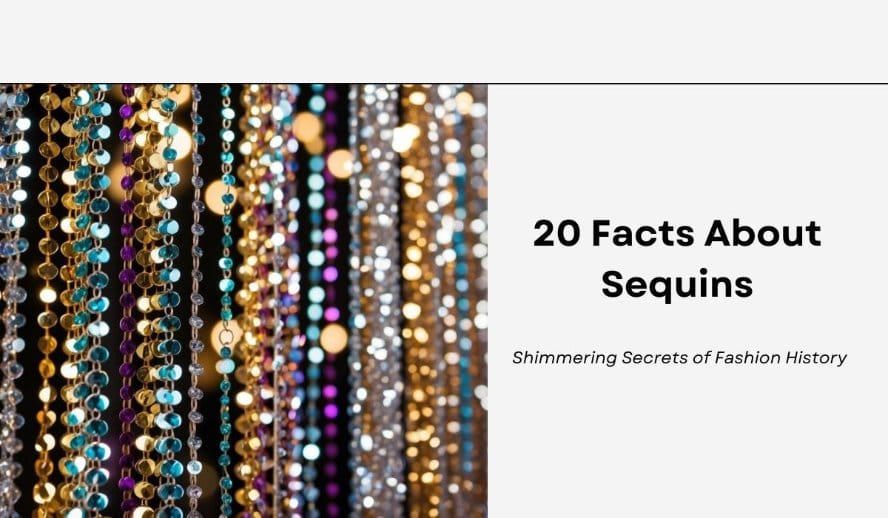From Ancient Egypt to Modern Runways: The Fascinating Journey of Sequined Fashion
Sequins have sparkled their way through history, captivating fashion lovers for centuries. These tiny discs of glamour have adorned everything from ancient Egyptian garments to modern runway looks. Sequins trace their origins back to King Tutankhamun’s tomb, where gold sequin-like discs were discovered on his clothing.
These shimmering embellishments have evolved over time, changing in material and meaning. Once made of precious metals and used as symbols of wealth, sequins are now often crafted from plastic and Mylar. They’ve become a staple in fashion, adding a touch of glitz to everyday wear and making bold statements on red carpets worldwide.
Sequins are set to be a major trend in 2025, bringing their signature sparkle to wardrobes across the globe. From subtle accents to head-to-toe looks, these lustrous discs continue to capture our imagination and light up the fashion world.
On This Page
Key Takeaways
- Sequins have a rich history dating back to ancient Egypt and continue to be a fashion staple
- The materials used for sequins have changed over time, from precious metals to modern synthetics
- Sequins symbolise glamour and are predicted to be a significant trend in 2025 fashion
The Origin of Sequins
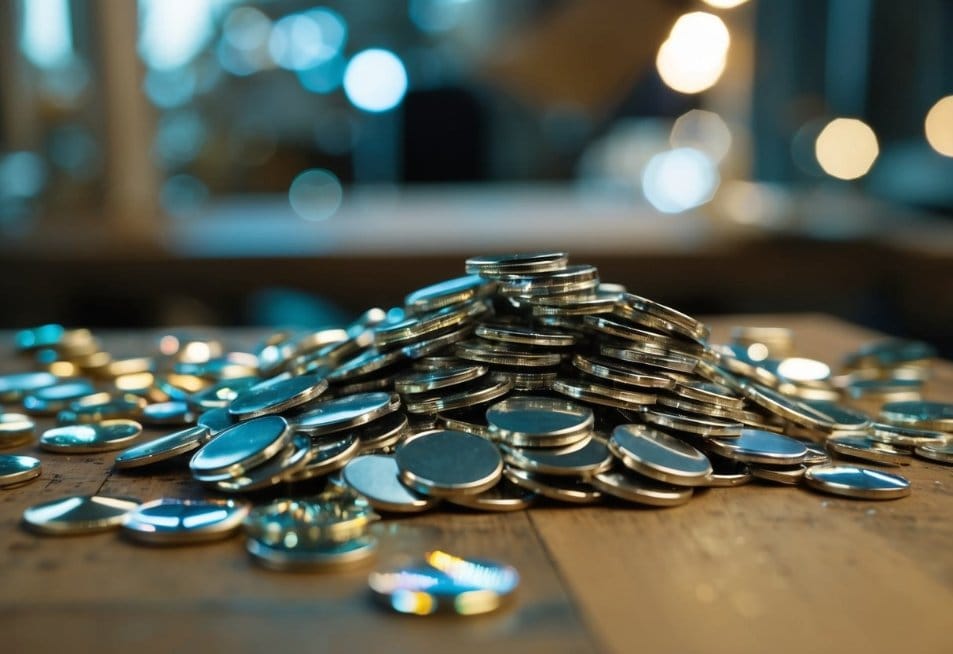
Sequins have a rich history dating back thousands of years. These shiny discs have adorned clothing and accessories since ancient times, with roots in Egypt and beyond.
Ancient Beginnings
Sequins began as small metal discs used for decoration and as currency. In ancient times, people sewed gold and silver coins onto their clothes to show wealth and status. This practice spread across many cultures.
The word ‘sequin’ comes from the Arabic ‘sikka’, meaning ‘coin’ or ‘minting die’. Venetian traders later adopted the term ‘zecchino’ for their gold coins in the 13th century.
Early sequins were made from precious metals like gold and silver. Craftsmen hammered these metals into thin sheets and cut out small circles. They then punched holes in the discs for sewing onto fabric.
Adoption in Egypt
Ancient Egyptians embraced sequins for their sparkle and symbolism. Gold sequin-like disks adorned the garments of pharaohs and nobles.
The discovery of King Tutankhamun’s tomb in 1922 revealed stunning examples of sequin use. His burial outfit featured thousands of gold discs, believed to ensure wealth in the afterlife.
Egyptian royalty saw sequins as more than mere decoration. These shimmering discs represented the sun god Ra and were thought to offer divine protection. Priests and priestesses also wore sequined garments during religious ceremonies.
Sequins Through the Ages
Sequins have played a significant role in fashion and culture for centuries. From medieval times to the post-war era, these shiny discs have been symbols of wealth, glamour, and innovation.
Medieval Wealth and Status
In medieval Europe, sequins were closely tied to wealth and status. The word ‘sequin’ comes from the Venetian ‘zecchino’, a gold coin used in the 16th century. Nobility and wealthy merchants sewed gold coins onto their garments as a display of affluence.
This practice wasn’t limited to Europe. In India, the ‘sikka’, a silver coin, was used similarly. The glittering effect of these coins on clothing was eye-catching and unmistakable.
Artisans soon began crafting metal discs specifically for decorating clothing. These early sequins were often made of precious metals, making them exclusive to the upper classes.
The Roaring 1920s
The 1920s saw sequins become more widely available and popular. Improvements in manufacturing techniques allowed for the mass production of lightweight, plastic sequins.
This coincided with the rise of disco fever and bold fashion. Flappers embraced sequins as part of their rebellious style. Sequined dresses, headbands, and accessories became symbols of the era’s exuberance.
Hollywood also played a role in popularising sequins. Silent film stars like Gloria Swanson dazzled audiences in sequined gowns, cementing the link between sequins and glamour.
Post-War Fashion and Sequins
After World War II, sequins took on new significance in fashion. The post-war economic boom allowed more people to afford sequined clothing. Designers embraced sequins as a way to add sparkle and optimism to their collections.
In 1952, DuPont invented Mylar, revolutionising sequin production. This new material was more durable and reflective than previous options. It allowed for even more creative uses of sequins in fashion.
From the 1950s onwards, sequins became a staple of eveningwear. They were particularly popular for holiday parties and New Year’s Eve celebrations. Sequins continue to be a symbol of festivity and glamour in modern fashion.
Cultural Impact and Iconic Moments
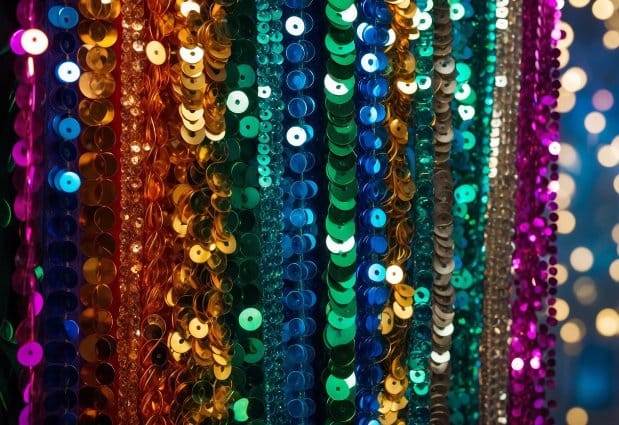
Sequins have dazzled audiences for decades, leaving an indelible mark on popular culture. From Hollywood glamour to music industry spectacles, these tiny sparklers have become synonymous with celebration and stardom.
Hollywood and Sequins
The silver screen and sequins have long been inseparable. Elizabeth Taylor’s wardrobe often featured sequined gowns, cementing their association with Hollywood glamour. In the 1950s and 60s, sequins became a staple for leading ladies, signifying elegance and star power.
Films like “Gentlemen Prefer Blondes” showcased Marilyn Monroe in iconic sequined dresses. These glittering costumes helped create unforgettable cinematic moments. Sequins also played a role in period dramas, adding authenticity to depictions of 1920s fashion.
Beyond the big screen, sequins have become a symbol of celebration. They’re a popular choice for New Year’s Eve outfits and Christmas party attire, bringing a festive sparkle to holiday gatherings.
Music Industry’s Sparkling Fashion
The music world has embraced sequins with open arms. Elton John’s flamboyant stage outfits often featured elaborate sequin designs, becoming part of his signature look. His sparkling costumes helped create a visual spectacle that matched his musical performances.
Michael Jackson’s iconic sequined glove became a symbol of his solo career. This single, glittering accessory was a key part of his image during the “Thriller” era. Jackson’s sequined outfits also played a crucial role in his legendary live performances, particularly during his moonwalk.
Motown artists like Diana Ross often donned sequined gowns, blending glamour with soulful music. These shimmering outfits became closely associated with the Motown sound and style.
Today, sequins continue to make statements on stage. Artists use them to create memorable looks for music videos, live shows, and red carpet events.
Material and Manufacturing
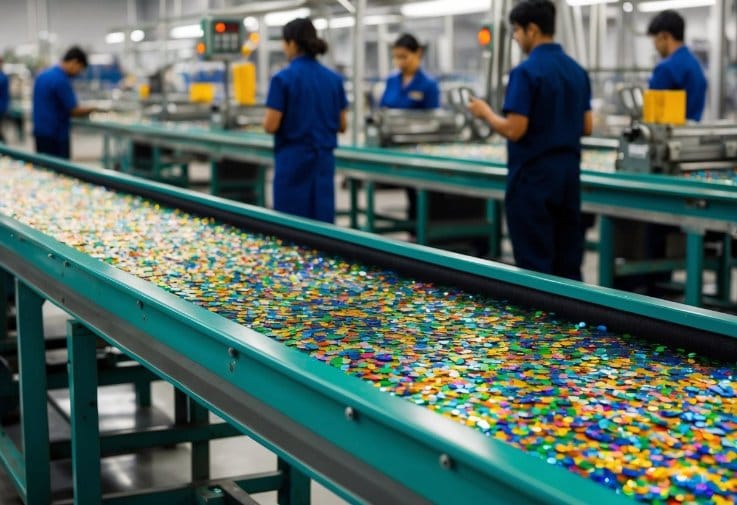
Sequins have undergone major changes in materials and production over time. New technologies have made sequins lighter, more durable, and easier to produce at scale.
Early Materials
Sequins were first made from metal. These shiny discs added sparkle but were heavy on garments. In the 1930s, manufacturers started using gelatin to make sequins. Gelatin sequins were much lighter than metal. But they had a big problem – they melted when exposed to heat or water.
To fix this, companies tried new materials. Eastman Kodak developed acetate film sequins in the 1950s. These were stronger than gelatin and didn’t melt as easily. Herbert Lieberman then created Mylar sequins in the 1960s. Mylar offered even more shine and durability.
Modern Advancements
Today, most sequins are made from vinyl plastic. Vinyl is cheap, light, and comes in many colours. It’s also tough enough to withstand washing and wear. Some brands now use recycled plastics to make sequins. This helps reduce waste.
New tech has also changed how sequins are made. Machines can now punch out thousands of sequins per minute. This has made sequins much cheaper. But it also creates a lot of waste material. Some firms are working on ways to cut down on this waste in sequin production.
Sequins in Contemporary Fashion
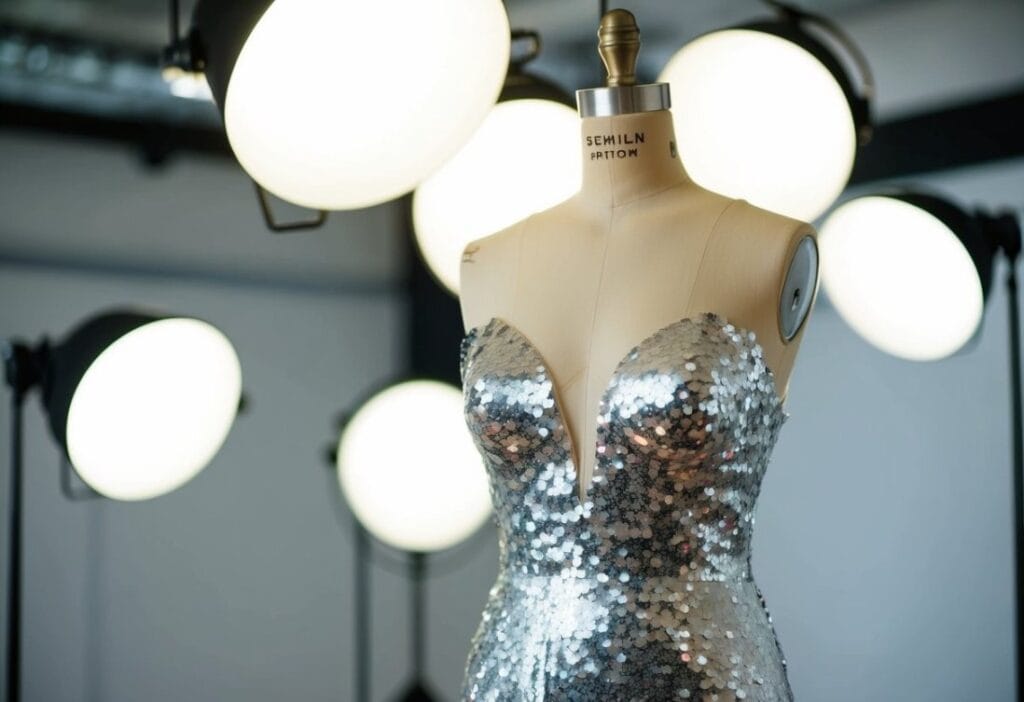
Sequins remain a dazzling staple in modern fashion, adorning everything from haute couture to high street styles. Designers and brands continue to push the boundaries of sequin use, creating innovative looks that captivate the runway and everyday wear alike.
Designer Highlights
Ashish Gupta stands out as a sequin enthusiast, crafting entire collections that sparkle and shine. His designs often feature bold patterns and colour combinations, elevating sequins beyond simple embellishments.
Other designers like Balmain and Valentino regularly incorporate sequins into their collections, using them to create dramatic silhouettes and eye-catching textures. These shimmering creations often dominate red carpet events and high-profile galas.
On the high street, brands such as Zara and Topshop offer more accessible sequin pieces, bringing glamour to everyday wardrobes. Sequin tops, skirts, and dresses have become popular choices for nights out and special occasions.
Trends and Innovation
Recent trends show a shift towards more sustainable sequin options. Designers are experimenting with biodegradable materials and recycled plastics to create eco-friendly alternatives to traditional plastic sequins.
Sequin accessories continue to evolve, with bags, shoes, and even phone cases getting the sparkle treatment. These items allow for a touch of glamour without committing to a full sequin outfit.
Innovative application techniques are emerging, such as reversible sequins that change colour when brushed in different directions. This adds an interactive element to garments, allowing wearers to customise their look.
Sequin patterns are becoming more intricate, with ombré effects and mixed-size sequins creating depth and texture. Some designers are even incorporating LED lights into sequin designs for a futuristic twist.
Sequins and Symbolism
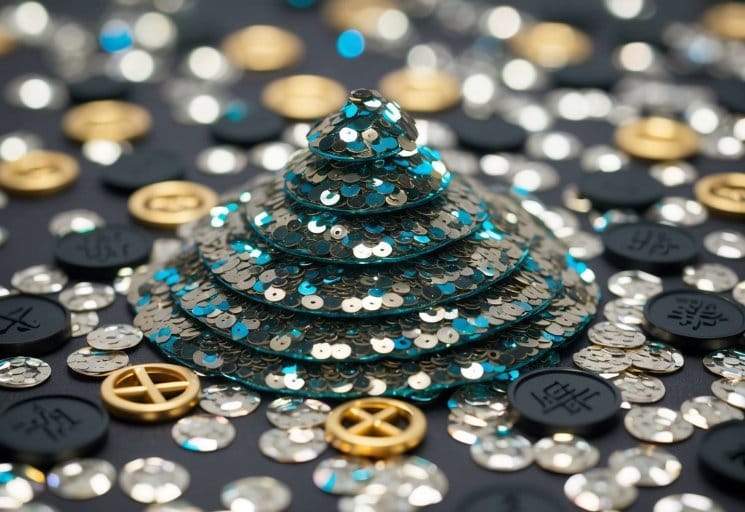
Sequins have held deep symbolic meaning across cultures and time periods. These shimmering discs represent more than mere decoration, embodying ideas of wealth, status, and even spiritual protection.
Symbols of Luxury and Prestige
Sequins have long been associated with wealth and status. The word ‘sequin’ itself comes from the Arabic ‘sikka’, meaning ‘coin’. In ancient Egypt, gold sequin-like discs adorned royal garments, signifying the wearer’s financial stability and prestige.
Throughout history, sequins continued to symbolise luxury. Their glittering appearance mimicked precious metals and gemstones, making them a more accessible way for people to display their status.
Today, sequins still evoke glamour and confidence. Wearing sequins often makes people feel more self-assured and ready to stand out in a crowd.
Protective Meanings
Beyond their association with wealth, sequins have also held protective symbolism in various cultures. Some believed the reflective nature of sequins could ward off evil spirits or negative energy.
In ancient burial practices, sequins played a role in ensuring financial stability in the afterlife. Garments adorned with gold discs were thought to provide the deceased with wealth in the next world.
The protective quality of sequins extends to modern times as well. Many view sequined garments as a form of armour, boosting confidence and helping the wearer feel shielded from negativity.
Caring for Sequined Apparel
Sequined garments require special care to maintain their sparkle and longevity. Proper maintenance and storage are key to preserving these dazzling pieces. Environmentally friendly practices can also be incorporated when caring for sequined clothing.
Maintenance and Storage
Cleaning sequined clothing requires gentle handling. Hand washing is often the safest method. Use cool water and a mild detergent. Gently swish the garment, avoiding rubbing or wringing. Rinse thoroughly and pat dry with a towel.
For drying, lay the item flat on a clean towel. Avoid hanging, as this can stretch the fabric and loosen sequins. Never use a tumble dryer, as heat can damage sequins.
Store sequined items flat or hung on padded hangers. Use garment bags to protect from dust. Avoid folding, which can crease the fabric and crack sequins.
Before wearing, steam the garment to refresh its appearance. Use a handheld steamer on a low setting, holding it several inches away from the fabric.
Environmentally Friendly Practices
Opt for sequined garments made with recycled materials to reduce environmental impact. These pieces offer the same glamour with a smaller carbon footprint.
When cleaning, choose eco-friendly detergents. These are gentler on sequins and better for the environment. Use cold water to save energy and preserve sequin adhesive.
Consider professional dry cleaning for heavily embellished items. Look for cleaners using green methods and solvents. Some sequined garments may require specific cleaning techniques, so always check the care label.
Repair loose sequins promptly to extend the garment’s life. This reduces the need for replacement and keeps clothing out of landfills. Learn basic sewing skills to reattach sequins at home.
Frequently Asked Questions
Sequins spark curiosity about their origins, uses, and production. These shimmering embellishments have a rich history and diverse applications in fashion and beyond.
What is the history behind sequins?
Sequins trace back to ancient times. They originated from coins called “sikka” in the Mediterranean region. People sewed these coins onto clothing for decoration and to show wealth.
Over time, sequins evolved from metal discs to lighter materials. Their popularity grew in the 20th century, especially in glamorous Hollywood costumes and stage wear.
How are sequins commonly used in clothing design?
Designers use sequins to add sparkle and drama to garments. They’re often seen on evening gowns, party dresses, and stage costumes.
Sequins can cover entire pieces or be used as accents. They create eye-catching patterns and textures on fabric. Fashion shows regularly feature sequined designs to make a bold statement.
What are sequins made of and how are they produced?
Modern sequins are typically made of plastic. Some are still crafted from metal or other materials like crystals.
Manufacturers produce sequins by cutting thin sheets of material into small shapes. These are usually round, but can be various forms like stars or hearts.
The sequins are then punched with holes for sewing onto fabric. Some have a metallic coating to enhance their shine.
Can you explain the evolution of sequin embellishments in fashion?
Sequin embellishments have changed with fashion trends. In the 1920s, flappers wore fully sequined dresses. The 1970s disco era saw a resurgence of sparkly outfits.
Today, sequins are set to be a major trend in 2025. Designers are using them in innovative ways, mixing them with other textures and materials.
What are some interesting uses of sequins beyond fashion?
Sequins have found their way into art and home decor. Artists create sequin murals and sculptures that change appearance when touched.
In crafts, sequins adorn greeting cards and scrapbooks. They’re also used in theatrical set design to create dazzling backdrops.
How has the role of sequins in children’s apparel developed over the years?
Sequins in children’s clothes have become more common. They often appear on t-shirts, dresses, and accessories like backpacks.
Some clothing brands now use reversible sequins that change colour when brushed. This interactive element appeals to children and adds a fun aspect to their outfits.
Related Post: What You Need to Know About Sequins: Essential Tips for Sparkling Style

